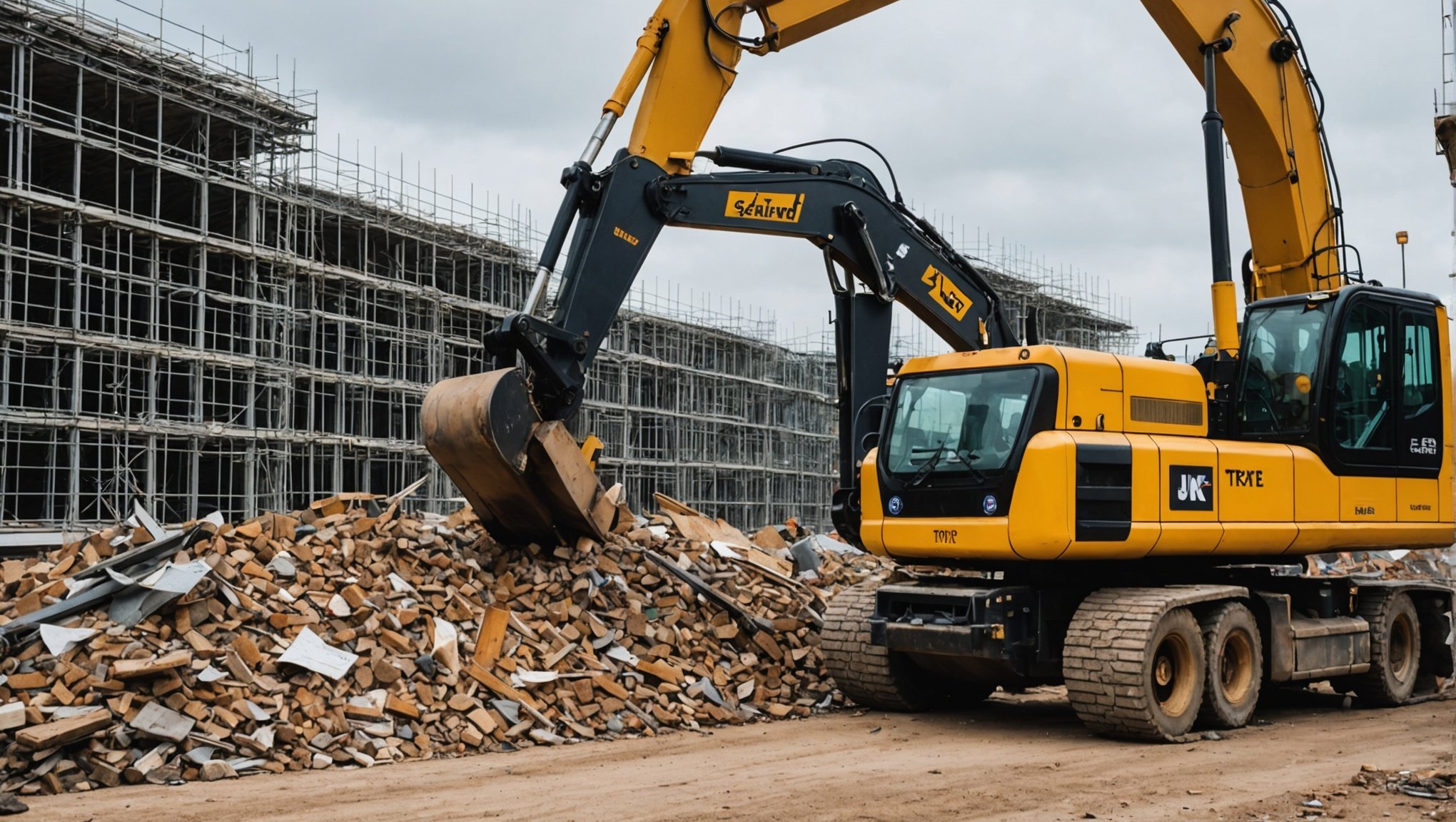Top Strategies for UK Construction Companies to Minimize Waste and Boost Sustainability
The construction industry, known for its significant environmental impact, is under increasing pressure to adopt sustainable practices and reduce waste. In the UK, construction companies are at the forefront of this transformation, implementing innovative strategies to minimize waste and enhance sustainability. Here, we delve into the top strategies that are shaping the future of the construction sector.
Shifting Towards Sustainable Materials
One of the most critical steps in reducing the environmental impact of construction is the adoption of sustainable materials. Traditional materials like concrete, while essential, come with a hefty carbon footprint. For instance, the production of cement, a key component of concrete, accounts for about 8% of the world’s carbon emissions[4].
Also to discover : Mastering Supply Chain Resilience: Proven Strategies for Navigating Disruptions in the UK
Alternatives to Traditional Materials
- Green Concrete: Made from recycled materials, green concrete offers a significant reduction in carbon footprint. This type of concrete can include recycled aggregate, supplementary cementitious materials, and even bio-concrete, where limestone-producing bacteria are used[4].
- Timber: Sourced from responsibly managed forests, timber is a renewable material that absorbs CO2 during its growth, making it a carbon-negative product. It is gaining popularity as a sustainable alternative to traditional building materials.
- Recycled and Reclaimed Materials: Using crushed recycled glass instead of sand in concrete mixtures or incorporating reclaimed bricks and tiles in new projects can significantly reduce waste and energy consumption.
| Material | Benefits | Environmental Impact Reduction |
|
|--------------------------------------------------------------------------|
|
| Green Concrete | Reduced carbon footprint, uses recycled materials | Up to 50% reduction in CO2 emissions |
| Timber | Renewable, carbon-negative, absorbs CO2 during growth | Significant reduction in carbon footprint |
| Recycled Glass | Reduces waste, lowers energy consumption | Minimizes landfill waste and energy use |
| Reclaimed Bricks | Reduces new material production, conserves resources | Decreases waste and energy consumption |
Enhancing Waste Management and Recycling Practices
Effective waste management is crucial for reducing the environmental impact of construction projects. The UK construction industry generates a substantial amount of waste, with a third of all waste in the UK coming from this sector[4].
Pre-Demolition Audits and Strategic Waste Planning
- Pre-Demolition Audits: These audits help identify construction waste materials before demolition, allowing for better management and minimization of waste. They are often required as part of the BREEAM process and are recommended by the London Plan to support circular economy statements[1].
- Strategic Waste Planning: Planning for waste reduction should be included in project plans from the outset. This includes ordering materials to exact measurements to minimize offcuts and choosing pre-fabricated components that generate less waste on site.
On-Site Waste Segregation and Recycling
- Segregating Waste: On-site segregation of waste makes it easier to recycle materials. Working with waste management companies that prioritize recycling over landfill disposal ensures responsible waste management.
- Material Passports: Implementing material passports, as seen in projects like One Exchange Square in London, allows for the logging of suitable materials for reuse. This facilitates urban mining and reduces the environmental impact during the end-of-life and deconstruction period[1].
Encouraging Innovative Sustainable Practices
Innovation is a driving force behind the move towards more sustainable construction practices.
Also to see : Transforming hydrogen storage: meet the delphy solution
Digital Technologies and BIM
- Building Information Modelling (BIM): BIM allows firms to visualize their projects in 3D, identifying and addressing potential environmental issues before construction begins. This technology optimizes material use, reduces waste, and enhances overall project efficiency[4].
- Advanced Simulation Software: These tools enable more precise formwork design, reducing material waste and optimizing performance. Companies like PERI Group are leveraging such technologies to develop reusable formwork systems that can be used up to 100 times[2].
Modular Construction and Prefabrication
- Modular Construction: This practice involves pre-fabricating parts of the building off-site, reducing waste and energy use. It also speeds up construction times and improves quality control.
- 3D Printing Technology: Companies like Laing O’Rourke are exploring the use of 3D printed formwork to create complex shapes with minimal waste and reduced labour requirements. This technology has the potential to revolutionize the industry by making construction more efficient and sustainable[2].
Collaborative Efforts and Policy Implementation
Creating circular solutions in construction requires a collaborative effort among all stakeholders.
Roles and Responsibilities
- Client Policies: Clients should set out policies for circular opportunities, steering developments and portfolios towards sustainable practices. This includes defining roles and responsibilities at the start of each project[1].
- Demolition Contractors: Demolition contractors must formulate clear and concise audits of materials, working with design teams to identify direct reuse opportunities both within the development and externally[1].
Learning from Best Practices
Countries like those in Scandinavia and the Netherlands have already embraced circularity in construction. Learning from their practices can provide valuable insights for future developments. For example, the integration of reusable materials and urban mining concepts can significantly reduce waste and environmental impact[1].
Case Study: Sweco’s Approach to Circular Economy in Construction
Sweco, a leading sustainability expert, is setting the standard for ‘reuse and recycle’ at One Exchange Square in London. Here’s a closer look at their approach:
- Material Passports: Sweco is using material passports to log and track materials from the foundations to the roof structure. This database encourages material reuse and reduces environmental impact during the end-of-life and deconstruction period[1].
- Urban Mining: By treating the city like a mine of rich resources, Sweco is facilitating wider-spread urban mining. This approach acknowledges the value of materials within existing buildings and allows for their extraction and reuse[1].
- Energy Savings: According to a recent Sweco report, adopting circular economy principles could save up to 75% of the total energy needs in future cities[1].
Practical Insights and Actionable Advice
For construction companies looking to embark on this sustainable journey, here are some practical insights and actionable advice:
Start with a Comprehensive Audit
- Conduct thorough pre-demolition audits to identify materials that can be reused or recycled.
- Use material passports to track and log materials for future reuse.
Adopt Sustainable Materials
- Explore alternatives to traditional materials like green concrete, timber, and recycled glass.
- Incorporate reclaimed materials into new projects to reduce waste and energy consumption.
Implement Innovative Technologies
- Utilize BIM and advanced simulation software to optimize material use and reduce waste.
- Consider modular construction and 3D printing technology to enhance efficiency and sustainability.
Foster Collaboration
- Define clear roles and responsibilities among stakeholders to ensure a collaborative effort towards sustainability.
- Learn from best practices in other countries and industries to implement effective sustainable strategies.
The journey towards sustainability in the construction industry is complex but rewarding. By shifting towards sustainable materials, enhancing waste management and recycling practices, encouraging innovative sustainable practices, and fostering collaborative efforts, UK construction companies can significantly reduce waste and boost sustainability.
As Emma Brown, Sustainability Director at Skanska UK, notes, “The formwork of tomorrow will not only shape our buildings but also our approach to sustainable construction. It’s an exciting time to be in this field, with innovations emerging that have the potential to transform the way we build”[2].
By embracing these strategies, construction companies can not only reduce their environmental impact but also contribute to a greener, more sustainable future for generations to come. The time to act is now, and the benefits of sustainable construction practices are undeniable. Let’s build a better, greener future together.











